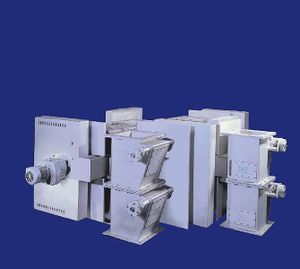Difference between revisions of "Double Flap Gate Valves"
(Created page with "Category:Valves{{Knoppen}} <noinclude><!------------------------------------------------ * READ THIS FIRST * Only edit this page if you can improve the content. * Improper u...") |
|||
| Line 1: | Line 1: | ||
[[Category:Valves]]{{Knoppen}} | [[Category:Valves]]{{Knoppen}} | ||
[[File:Double Flap Gate Valves1.jpg|thumb|right|Double Flap Gate Valves]] | |||
[[File:Double Flap Gate Valves.jpg|thumb|right|Double Flap Gate Valves]] | |||
'''Double Flap Gate Valves''' are a type of airlock valve commonly used in industrial applications as a component in bulk material handling applications. These are primarily used to discharge chunky or fibrous, bulk materials from hoppers, bins, and cyclones operating under positive or negative pressure and are used to discharge a flow of material while at the same time serving as an airlock transition point to preserve the pressure differential above and below the valve. This type of material handling valve is ideal for use with bulky or abrasive materials that would tend to jam or damage a rotary feeder. | |||
* | |||
* | |||
==Principle of operation== | |||
The double flap gate valve controls the rate of material flow through a system,while at the same time preventing air leakage by isolating the processing system's pressures.The | |||
double flap gate valves are designed for high-pressure applications up to 20 psi and temperature extremes up to 1,650˚For higher depending upon the application.Double flap gate product that can operate reliably in pneumatic conveying systems at these pressures | |||
==Applications== | |||
* Batch Feeding | |||
* Mixing | |||
* Drying | |||
* Material Recovery | |||
* Pneumatic Conveying | |||
* Dust Collection | |||
Unlike a rotary valve that inevitably has some air leakage because of the clearance required between the blades and the housing, the double flap gate valve is designed to seal completely and isn't subject to the kind of wear that rotary valves would endure under extreme application conditions. | |||
Latest revision as of 05:24, 12 January 2013
Double Flap Gate Valves are a type of airlock valve commonly used in industrial applications as a component in bulk material handling applications. These are primarily used to discharge chunky or fibrous, bulk materials from hoppers, bins, and cyclones operating under positive or negative pressure and are used to discharge a flow of material while at the same time serving as an airlock transition point to preserve the pressure differential above and below the valve. This type of material handling valve is ideal for use with bulky or abrasive materials that would tend to jam or damage a rotary feeder.
Principle of operation
The double flap gate valve controls the rate of material flow through a system,while at the same time preventing air leakage by isolating the processing system's pressures.The double flap gate valves are designed for high-pressure applications up to 20 psi and temperature extremes up to 1,650˚For higher depending upon the application.Double flap gate product that can operate reliably in pneumatic conveying systems at these pressures
Applications
- Batch Feeding
- Mixing
- Drying
- Material Recovery
- Pneumatic Conveying
- Dust Collection
Unlike a rotary valve that inevitably has some air leakage because of the clearance required between the blades and the housing, the double flap gate valve is designed to seal completely and isn't subject to the kind of wear that rotary valves would endure under extreme application conditions.

